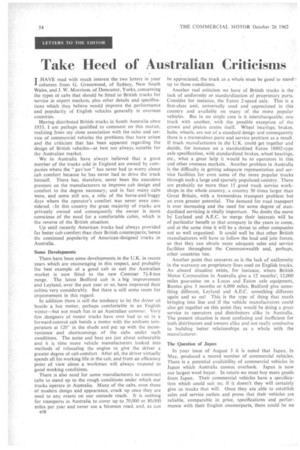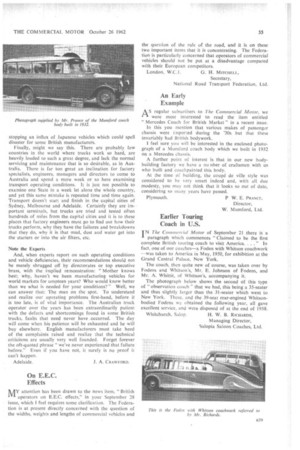Take Heed of Australian Criticisms
Page 56

Page 57

If you've noticed an error in this article please click here to report it so we can fix it.
T HAVE read with much interest the two letters in your
columns from G. Greenwood, of Sydney, New South Wales, and J. W. Morrison, of Doncaster, Yorks, concerning the types of cabs that should be fitted to British trucks for service in export markets, plus other details and specifications which they believe would improve the performance and popularity of English vehicles generally in overseas countries.
Having distributed British trucks in South Australia since 1933, I am perhaps qualified to comment on this matter, realizing from my close association with the .sales and service of commercial vehicles the problems that have arisen and the criticism that has been apparent regarding the design of British vehicles—at best not always suitable for the Australian market.
We in Australia have always believed that a great number of the trucks sold in England are owned by companies where the " guv'nor " has never had to worry about cab comfort because he has never had to drive the truck himself. There has, therefore, never been the executive pressure on the manufacturers to improve cab design and comfort to the degree necessary; and in fact many cabs were, and some still are, a relic of the horse-and-buggy days where the operator's comfort was never even considered. In this country the great majority of trucks are privately owned and consequently • the owner is more conscious of the need for a comfortable cabin, which is the reverse of the British situation.
Up until recently American trucks had always provided far better cab comfort than their British counterparts; hence the continued popularity of American-designed trucks in Australia.
Some Developments • There have been some developments in the U.K. in recent years which are encouraging in this respect, and probably the best example of a good cab to suit the Australian market is now fitted to the new Commer 71-8-ton range. The latest Bedford cab is a big improvement and Leyland, over the past year or so, have improved their cabins very considerably. But there is still some room for improvement in this regard.
In addition there is still the tendency to let the driver sit beside a hot motor, perhaps comfortable in an English winter—but not much fun in an Australian summer. Very few designers of motor trucks have ever had to sit in a forward-control cab beside a motor with the ambient temperature at 1200 in the shade and put up with the inconvenience and shortcomings of the cabs under such conditions. The noise and heat are just about unbearable and it is time more vehicle manufacturers looked into methods of relocating the engine to give the driver a greater degree of cab comfort. After all, the driver virtually spends all his-working life in the cab, and from an efficiency point ofview alone a workman will always respond to good working conditions.
There is also need for some manufacturers to construct cabs to stand up to the rough conditions under which our trucks operate in Australia. Many of the cabs, even those of modern design and appearance, crack up once they are used to any extent on our unmade roads. It is nothing for transports in Australia to cover up to 70,000 or 80,000 miles per year and never use a bitumen road, and, as can B38 be appreciated, the truck as a whole must be good to stand up to these conditions. .
Another real criticism we have of British trucks is the lack of uniformity or standardization of proprietary parts. Consider for instance, the Eaton 2-speed axle. This is a first-class unit, universally used and appreciated in this country and available on many of the more popular vehicles. But in no single case is it interchangeable, one truck with another, with the possible exception of the crown and pinion centre itself. Wheel bearings, brakes,• hubs, wheels, are not of a standard design and consequently there is a tremendous parts and service problem as a result. If truck manufacturers in the U.K. could get together and decide, for instance on a standardized Eaton 18802-type axle specification, with standardized brakes, wheel bearings, etc., what a great help it would be to operators in this and other overseas markets. Another problem in Australia is the difficulty in getting adequate representation and service facilities for even some of the more popular trucks through such a large and sparsely populated country. There are probably no more than 15 good truck service workshops in the whole country, a country 30 times larger than Great Britain, with a tremendous transport problem but an even greater potential. The demand for road transport is ever increasing and the need for some degree of standardized servicing is vitally important. No doubt the move bi Leyland and A.E.C. to merge their interests will be of particular benefit to that company in the years to come, and at the same time it will be a threat to other companies not so well organized. It could well be that other British manufacturers will have to follow the lead and join forces, so that they can obtain more adequate sales and service facilities throughout the Commonwealth and, perhaps, other countries too.
Another point that concerns us is the lack of uniformity in the warranty on proprietary lines used on English trucks. An absurd situation exists, for instance, where British Motor Corporation in Australia give a 12 months', 12,000 miles guarantee on a Lucas and Eaton axle equipment, Rootes give 3 months or 6,000 miles, Bedford give something different, Leyland and A.E.C. something different again and so on This is the type of thing that needs bringing into line and if the vehicle manufacturers could also get together on this point they would be doing a great service to operators and distributors alike in Australia. The present situation is most confusing and inefficient for both distributors and owners alike and not really conducive to building better relationships as a whole with the manufacturer.
The Question of Japan In your issue of August 3 it is noted that Japan, in May, produced a record number of commercial vehicles. There is a potential availability of commercial vehicles in Japan which Australia cannot overtook. Japan is now our largest wool buyer. In return we must buy more goods from Japan. Their commercial vehicles have a specification which could suit us; if it doesn't they will certainly give us trucks that will. Once they are able to establish sales and service outlets and prove that their vehicles are reliable, comparable in price, specifications and performance with their English counterparts, there could be no stopping an influx of Japanese vehicles which could spell disaster for some British manufacturers.
Finally, might we say this. There are probably few countries in the world where trucks work so hard, are heavily loaded to such a great degree, and lack the normal servicing and maintenance that is so desirable, as in Australia. There is far too great an inclination for factory specialists, engineers, managers and directors to come to Australia and spend a mere week or so here examining transport operating conditions. It is just not possible to examine one State in a week let alone the whole country, and yet this same mistake is repeated time and time again. Transport doesn't start and finish in the capital cities of Sydney, Melbourne and Adelaide. Certainly they are important terminals, but trucks are tried and tested often hundreds of miles from the capital cities and it is to these places that factory engineers must go to find out how their trucks perform, why they have the failures and breakdowns that they do, why it is that mud, dust and water get into the starters or into the air filters, etc.
Note the Experts And, when experts report on such operating conditions and vehicle deficiencies, their recommendations should not be merely shrugged off by directorates or top executive brass, with the implied remonstration: "Mother knows best; why, haven't we been manufacturing vehicles for world markets for umpteen years? Who would know better than we what is needed for your conditions?" Well, we can answer that: The man on the spot. To understand and realize our operating problems first-hand, before it is too late, is of vital importance. The Australian truck operator over the years has been extraordinarily patient with the defects and shortcomings found in some British trucks, faults that need never have occurred. The day will come when his patience will be exhausted and he will buy elsewhere. English manufacturers must take heed of the complaints raised and realize that the technical criticisms are usually very well founded. Forget forever the oft-quoted phrase "we've never experienced that failure before." Even if you have not, it surely is no proof it can't happen.
Adelaide. J. A. CRAWFORD.
On E.E.C. Effects
MY attention has been drawn to the news item, "British operators on E.E.C. effects," in your September 28 issue, which I feel requires some clarification. The Federation is at present directly concerned with the question of the widths, weights and lengths of commercial vehicles and
the question of the rule of the road, and it is on these two important items that it is concentrating. The Federation is particularly concerned that operators of commercial vehicles should not be put at a disadvantage compared with their European competitors.
London, W.C.I. G. H. MITCHELL, Secretary, National Road Transport Federation, Ltd.
An Early Example
AS regular subscribers to The Commercial Motor, we were most interested to read the item entitled "Mercedes Coach for British Market " in a recent issue.
In this you mention that various makes of passenger chassis were imported during the '30s but that these invariably had British bodywork.
I feel sure you will be interested in the enclosed photograph of a Mumford coach body which we built in 1932 on a Mercedes chassis.
A further point of interest is that in our new bodybuilding factory we have a nu Tiber of craftsmen with us who built and coachpainted this body.
At the time of building, the coupe de vine style was considered to be very smart indeed and, with all due modesty, you may not think that it looks so out of date, considering so many years have passed.
Plymouth. P W. E. PRANCE, Director, W. Mumford, Ltd.
Earlier Touring Coach in U.S.
TN The Commercial Motor of September 21 there is a paragraph which commences "Claimed to be the first
complete British touring coach to visit America. " In fact, one of our coaches—a Foden with Whitson coachwork —was taken to America in May, 1950, for exhibition at the Grand Central Palace, New York.
The coach, then quite new of course, was taken over by Fodens and Whitson's, Mr. E. Johnson of Fodens, and Mr. A. Whittit, of Whitson's, accompanying it.
The photograph below shows the second of this type of "observation coach" that we had, this being a 35-seater and thus slightly larger than the 31-seater which went to New York. These, and the 39-seat rear-engined Whitsonbodied Fodens we obtained the following year, all gave excellent service, and were disposed of at the end of 1958.
Whitchurch, Salop. H. W. B. RICHARDS, Managing Director, Salopia Saloon Coaches, Ltd.




































































































